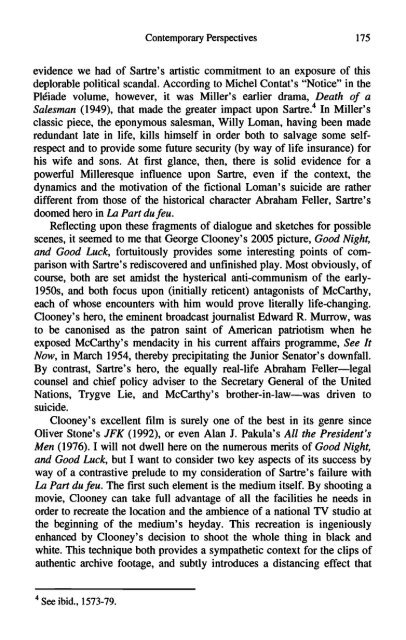Sartre's second century
Sartre's second century
Sartre's second century
You also want an ePaper? Increase the reach of your titles
YUMPU automatically turns print PDFs into web optimized ePapers that Google loves.
Contemporary Perspectives 175<br />
evidence we had of <strong>Sartre's</strong> artistic commitment to an exposure of this<br />
deplorable political scandal. According to Michel Contat's "Notice" in the<br />
Pleiade volume, however, it was Miller's earlier drama, Death of a<br />
Salesman (1949), that made the greater impact upon Sartre. 4 In Miller's<br />
classic piece, the eponymous salesman, Willy Loman, having been made<br />
redundant late in life, kills himself in order both to salvage some selfrespect<br />
and to provide some future security (by way of life insurance) for<br />
his wife and sons. At first glance, then, there is solid evidence for a<br />
powerful Milleresque influence upon Sartre, even if the context, the<br />
dynamics and the motivation of the fictional Loman's suicide are rather<br />
different from those of the historical character Abraham Feller, <strong>Sartre's</strong><br />
doomed hero in La Part dufeu.<br />
Reflecting upon these fragments of dialogue and sketches for possible<br />
scenes, it seemed to me that George Clooney's 2005 picture, Good Night,<br />
and Good Luck, fortuitously provides some interesting points of comparison<br />
with <strong>Sartre's</strong> rediscovered and unfinished play. Most obviously, of<br />
course, both are set amidst the hysterical anti-communism of the early-<br />
1950s, and both focus upon (initially reticent) antagonists of McCarthy,<br />
each of whose encounters with him would prove literally life-changing.<br />
Clooney's hero, the eminent broadcast journalist Edward R. Murrow, was<br />
to be canonised as the patron saint of American patriotism when he<br />
exposed McCarthy's mendacity in his current affairs programme, See It<br />
Now, in March 1954, thereby precipitating the Junior Senator's downfall.<br />
By contrast, <strong>Sartre's</strong> hero, the equally real-life Abraham Feller—legal<br />
counsel and chief policy adviser to the Secretary General of the United<br />
Nations, Trygve Lie, and McCarthy's brother-in-law—was driven to<br />
suicide.<br />
Clooney's excellent film is surely one of the best in its genre since<br />
Oliver Stone's JFK (1992), or even Alan J. Pakula's All the President's<br />
Men (1976). I will not dwell here on the numerous merits of Good Night,<br />
and Good Luck, but I want to consider two key aspects of its success by<br />
way of a contrastive prelude to my consideration of <strong>Sartre's</strong> failure with<br />
La Part dufeu. The first such element is the medium itself. By shooting a<br />
movie, Clooney can take full advantage of all the facilities he needs in<br />
order to recreate the location and the ambience of a national TV studio at<br />
the beginning of the medium's heyday. This recreation is ingeniously<br />
enhanced by Clooney's decision to shoot the whole thing in black and<br />
white. This technique both provides a sympathetic context for the clips of<br />
authentic archive footage, and subtly introduces a distancing effect that<br />
4 See ibid., 1573-79.
















